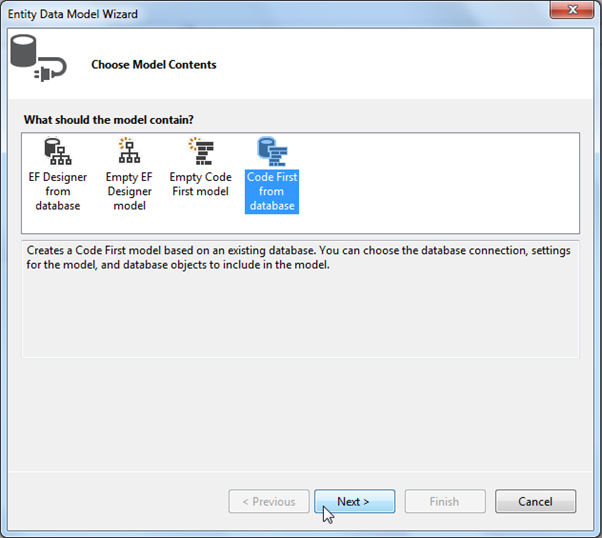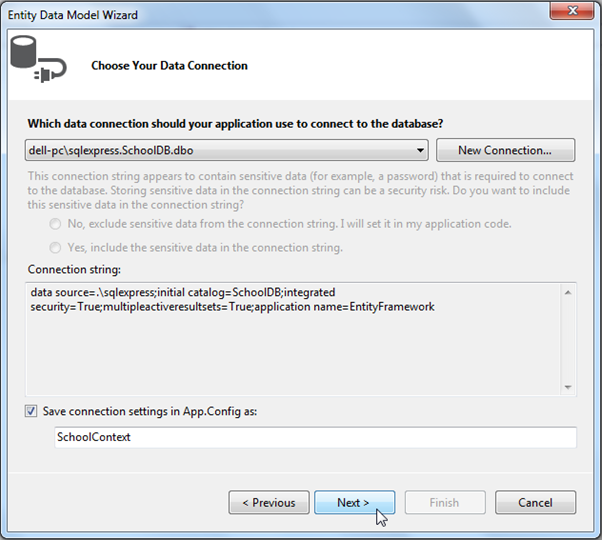【译】第28节---已有数据库
原文:http://www.entityframeworktutorial.net/code-first/code-first-from-existing-database.aspx
本节,将学习如何为现有数据库生成Code First上下文和实体类。
EF为现有数据库使用Code First方法提供了一种简单的方式。 它将为现有数据库中的所有表和视图创建实体类,并使用DataAnnotations属性和Fluent API进行配置。
要在现有数据库中使用Code First,右键点击项目 - > 新建 - > 新建项:

在添加新项目对话框中选择ADO.NET实体数据模型,并指定模型名称(这将是上下文类名称),然后单击添加:

这将打开实体数据模型向导,如下所示。 从数据库选项中选择代码,然后单击下一步:

现在,选择现有数据库的数据连接。 如果下拉列表不包含与现有数据库的连接,请为数据库创建新连接。 单击下一步继续:

现在,选择要生成类的表和视图,然后单击完成:

这将生成数据库表和视图的所有实体类,如下所示:

例如,它将创建以下上下文类,它使用Fluent API根据数据库配置实体类:
namespace EFDemo { using System; using System.Data.Entity; using System.ComponentModel.DataAnnotations.Schema; using System.Linq; public partial class SchoolContext : DbContext { public SchoolContext() : base("name=SchoolContext2") { } public virtual DbSet<Course> Courses { get; set; } public virtual DbSet<Standard> Standards { get; set; } public virtual DbSet<Student> Students { get; set; } public virtual DbSet<StudentAddress> StudentAddresses { get; set; } public virtual DbSet<Teacher> Teachers { get; set; } public virtual DbSet<View_StudentCourse> View_StudentCourse { get; set; } protected override void OnModelCreating(DbModelBuilder modelBuilder) { modelBuilder.Entity<Course>() .Property(e => e.CourseName) .IsUnicode(false); modelBuilder.Entity<Course>() .HasMany(e => e.Students) .WithMany(e => e.Courses) .Map(m => m.ToTable("StudentCourse").MapLeftKey("CourseId").MapRightKey("StudentId")); modelBuilder.Entity<Standard>() .Property(e => e.StandardName) .IsUnicode(false); modelBuilder.Entity<Standard>() .Property(e => e.Description) .IsUnicode(false); modelBuilder.Entity<Standard>() .HasMany(e => e.Students) .WithOptional(e => e.Standard) .WillCascadeOnDelete(); modelBuilder.Entity<Standard>() .HasMany(e => e.Teachers) .WithOptional(e => e.Standard) .WillCascadeOnDelete(); modelBuilder.Entity<Student>() .Property(e => e.StudentName) .IsUnicode(false); modelBuilder.Entity<Student>() .Property(e => e.RowVersion) .IsFixedLength(); modelBuilder.Entity<Student>() .HasOptional(e => e.StudentAddress) .WithRequired(e => e.Student) .WillCascadeOnDelete(); modelBuilder.Entity<StudentAddress>() .Property(e => e.Address1) .IsUnicode(false); modelBuilder.Entity<StudentAddress>() .Property(e => e.Address2) .IsUnicode(false); modelBuilder.Entity<StudentAddress>() .Property(e => e.City) .IsUnicode(false); modelBuilder.Entity<StudentAddress>() .Property(e => e.State) .IsUnicode(false); modelBuilder.Entity<Teacher>() .Property(e => e.TeacherName) .IsUnicode(false); modelBuilder.Entity<Teacher>() .HasMany(e => e.Courses) .WithOptional(e => e.Teacher) .WillCascadeOnDelete(); modelBuilder.Entity<View_StudentCourse>() .Property(e => e.StudentName) .IsUnicode(false); modelBuilder.Entity<View_StudentCourse>() .Property(e => e.CourseName) .IsUnicode(false); } } }

